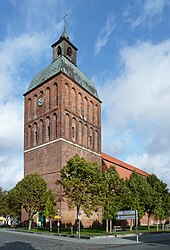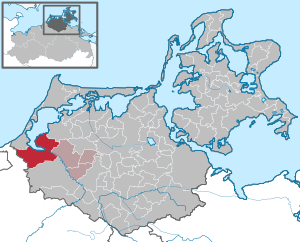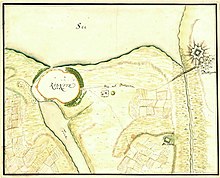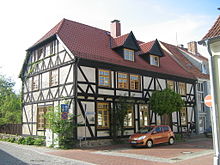Ribnitz-Damgarten
| coat of arms | Germany map | |
|---|---|---|

|
Coordinates: 54 ° 15 ' N , 12 ° 28' E |
|
| Basic data | ||
| State : | Mecklenburg-Western Pomerania | |
| County : | Western Pomerania-Ruegen | |
| Office : | Ribnitz-Damgarten | |
| Height : | 10 m above sea level NHN | |
| Area : | 122.48 km 2 | |
| Residents: | 15,235 (Dec. 31, 2019) | |
| Population density : | 124 inhabitants per km 2 | |
| Postal code : | 18311 | |
| Area code : | 03821 | |
| License plate : | VR, GMN, NVP, RDG, RÜG | |
| Community key : | 13 0 73 075 | |
| LOCODE : | DE RZD | |
City administration address : |
Am Markt 1 18311 Ribnitz-Damgarten |
|
| Website : | ||
| Mayor : | Thomas Huth (The Independents) | |
| Location of the town of Ribnitz-Damgarten in the Vorpommern-Rügen district | ||
Ribnitz-Damgarten is a town in the district of Vorpommern-Rügen in Mecklenburg-Vorpommern (Germany). It is also the administrative seat of the office of the same name , to which three other municipalities belong. The city is one of the 18 middle-class centers in the country and has had the amber city in front of its name since 2009.
Historically, the Ribnitz district belongs to Mecklenburg , Damgarten to Western Pomerania , in 1950 they were united into one town.
geography
Geographical location
The city is located between the Hanseatic cities of Rostock and Stralsund at the mouth of the Recknitz River in the Ribnitzer See (southern part of the Saaler Bodden ). East of the Recknitz in Western Pomerania is Damgarten and west of the river, in Mecklenburg, is Ribnitz.
City structure
Ribnitz-Damgarten consists of the districts Ribnitz and Damgarten and the following districts:
|
|
|
Neighboring communities
The following municipalities border on Ribnitz-Damgarten (clockwise, starting from the north): Saal , Ahrenshagen-Daskow , City of Marlow , Gelbensande and Dierhagen .
history
Ribnitz (1233-1950)
The result is Ribnitz from the village Rybanis ( Ryba means "fish"), which in the marshy Recknitzniederung was. The transition over the Recknitz is also called the Mecklenburg Pass . On the Ribnitz side, the pass farm is located directly on the river .
To protect the important river crossing over the Recknitz, the Mecklenburg princes had a castle built near the river around 1200, which later became the nucleus of the Ribnitz town center. Until the 14th century, the place belonged to the rulership of Rostock , then to the principality, and later to the (Grand) Duchy of Mecklenburg.
Ribnitz is first mentioned in a document from 1233. In 1323 the Ribnitz Poor Clare Monastery was founded by Prince Heinrich II of Mecklenburg . Until the end of the Thirty Years War in 1648, the Recknitz between Ribnitz and Damgarten formed the border between the Duchy of Mecklenburg and the Duchy of Pomerania , then until 1815 between Mecklenburg and Swedish Pomerania .
Another economic upswing in the city of Ribnitz began in 1934 with the construction of production facilities that were important for the war effort, such as Walther-Bachmann-Flugzeugbau KG.
Damgarten (1258–1950)
The town of Damgarten arose from a border castle and the neighboring village of "Damgor" ("Dam" means "oak"), which lay east of the swampy Recknitz lowland. Prince Jaromar II of Rügen is considered to be the founder of Damgarten . The transition over the Recknitz to Ribnitz in Mecklenburg was also called the Mecklenburg Pass . Damgarten received the Luebian law in 1258 from Rügen prince Jaromar II.
Until the end of the Thirty Years' War in 1648, the Recknitz between Ribnitz and Damgarten formed the border between the Duchy of Pomerania and the Duchy of Mecklenburg . Thereafter until 1815 between Swedish Pomerania and Mecklenburg. In 1809, when the irregulars under Major Ferdinand von Schill passed through, there were occasional skirmishes with the Mecklenburg regiments loyal to Napoleon. After 1815, Swedish Pomerania and Damgarten fell to the Kingdom of Prussia and then belonged to the province of Pomerania .
Damgarten has had a rail connection on the Stralsund – Rostock railway line since 1888 . In 1934 an air base near Pütnitz was built near Damgarten . The airfield Pütnitz was after the Second World War, one of the most important locations in the GDR stationed Soviet air forces . Until 1991 the 16th fighter division of the group of the Soviet armed forces in Germany was stationed in Damgarten.
Ribnitz-Damgarten (1950–1990)
The twin town Ribnitz-Damgarten was created on July 1, 1950 by merging the two towns Ribnitz (in Mecklenburg ) and Damgarten (in Pomerania ). Both city councils had spoken out against the merger of the cities. The Borg parish joined them on the same day. The rulers at the time wanted to erase any memory of Pomerania and the associated historical Mecklenburg-Pomerania border. Officially, the need for a larger district town for the Ribnitz-Damgarten district formed in 1952 in the GDR district of Rostock was put forward.
The Recknitz forms the natural border between Mecklenburg and Pomerania . The two districts of Ribnitz and Damgarten are separated by the wide swampy river valley. The transition over the Recknitz is also called the Mecklenburg Pass . On the Mecklenburg side, the pass farm is located directly on the river .
Ribnitz-Damgarten (since 1990)
From 1990 to 1994 Ribnitz-Damgarten still belonged to the district of the same name, now in the state of Mecklenburg-Western Pomerania . In 1994 the city was incorporated into the North Western Pomerania district. Since the district reform in 2011 , it has been in the Vorpommern-Rügen district .
After the political change, the historic town centers of Ribnitz with the monastery and of Damgarten were fundamentally renovated as part of urban development funding.
Population development
|
|
Status: December 31 of the respective year

On December 31, 2018 Ribnitz had 9,956 inhabitants, Damgarten 3,289 inhabitants.
religion
According to the historical circumstances in Mecklenburg and Pomerania, the predominantly Christian denomination is Protestantism. While the parish of Ribnitz St. Marien belongs to the Evangelical Lutheran Church of Mecklenburg , the parish of St. Bartholomew in Damgarten belongs to the Pomeranian Evangelical Church .
Other churches represented in Ribnitz-Damgarten are the Roman Catholic Maria-Hilfe der Christisten St. Klara and the New Apostolic parish Ribnitz.
politics
City council
Since the local elections on May 26, 2019 , the 25 city representatives are distributed as follows:
| Party / list | Seats |
|---|---|
| CDU | 7th |
| The independents | 5 |
| AfD | 3 |
| The left | 3 |
| SPD | 3 |
| FDP | 2 |
| Civic alliance | 1 |
| Alliance 90 / The Greens | 1 |
The CDU and FDP as well as the SPD and the Greens have each formed a parliamentary group.
mayor
- 1990–2013: Jürgen Borbe (CDU)
- 2013–2020: Frank Ilchmann (independent)
- since 2020: Thomas Huth (The Independent)
Huth was elected in the mayoral election on March 15, 2020 with 50.9% of the valid votes for a term of seven years.
coat of arms
The coat of arms was approved by the Ministry of the Interior on January 27, 1993 and registered under the number 64 of the coat of arms of Mecklenburg-Western Pomerania.
Blazon : “Split; in front in silver a crowned bust of a man with gold-trimmed blue cloak, in red clad, gold-haired and crowned, behind in blue an upright, red-tongued golden griffin. "
The coat of arms was designed by Frank Rose from Ribnitz-Damgarten .
On the heraldic right side of the coat of arms the Damgarten city founder Jaromar II of Rügen can be seen. The griffin on the left is the heraldic animal of the princes of the historical rulership of Rostock , to which Ribnitz belonged. Later one had a coat of arms with the Mecklenburg bull's head, flanked by two fish, which indicates the Slavic name Rybanis - fish place.
flag
The flag of the city of Ribnitz-Damgarten is striped in red - white - blue - yellow across the longitudinal axis of the flag cloth. The red and yellow stripes each take up an eighth, the white and blue stripes each take up three eighths of the length of the flag cloth. In the middle of the white stripe is the figure from the front field of the city's coat of arms. In the middle of the blue stripe is the figure from the back field of the city's coat of arms. The heraldic figures each occupy half the height of the flag cloth. The length of the flag is related to the height like 3: 2.
Town twinning
Ribnitz-Damgarten has maintained a partnership with the Lower Saxony city of Buxtehude since 1990 and with the Polish city of Sławno (formerly Schlawe ) in the West Pomeranian Voivodeship since 2008 .
Sights and culture
Buildings
- Ribnitz
- Poor Clare Monastery Ribnitz from 1323/24 with an exhibition on the history of the monastery and later evangelical aristocratic women's monastery
- Monastery church with Gothic wooden sculpture
- Marienkirche Ribnitz from 1233, rebuilt several times
- Rostocker Tor , built in the 15th century on the site of a previous building from 1290
- Long street with classical architecture
- Market with amber fountain and town hall from 1834
- German Amber Museum in the Poor Clare Monastery
- Open-air museum Klockenhagen in the district of Klockenhagen, including the museum church
- Gallery in the monastery
- Stadtkulturhaus “Am Bleicherberg”, performs guest performances on the Low German stage, dance, cabaret, concerts, readings, slide shows and children's events. Since 1999, the cinema of the Cinema Communication Mecklenburg-Vorpommern .

- Damgarten
- Evangelical St. Bartholomew Church from the 13th century
- Sexton's house by the church
- Amber Manufactory
- Town hall from 1930, next to it the oldest house in the city (Schillstrasse 7, built around 1700)
- Half-timbered house from 1769 in Stralsunder Straße 29 (Matheus)
- Technology Museum Pütnitz
- Langendamm
The so-called Moischenstein is located in the reed belt on the bank of the southern Saaler Bodden. The corridor and legal monument from the 13th century was the boundary stone between Mecklenburg and Pomerania. Today the stone still has a legal function for the town of Ribnitz-Damgarten with regard to the scope of their fishing rights in the western part of the Saaler Bodden. Next to the now largely sunken stone monument, the surface of which is heart-shaped, there is a raised stand and an imitation border post.
Memorials
- Memorial plaque for the prevented murder of female prisoners from the death march of the subcamp of the Ravensbrück concentration camp in April 1945 at the town hall
- Memorial for the victims of fascism from 1965 on the monastery meadows by the sculptor Wilhelm Löber
- Commemorative plaque for the communist anti-fascist Hans Burmeister, who died in 1934 from the abuse he suffered in Dreibergen-Bützow prison , in Frankenstrasse. The plaque was removed in 1974 and the street that bore his name was de-dedicated in 1991 and renamed "Rostocker Straße"
- Granite obelisk in memory of the Jewish victims of the Shoah in the municipal cemetery on the site of the former Jewish cemetery
- Three stumbling blocks in the Ribnitz district (since August 2011) → List of stumbling blocks in Ribnitz-Damgarten
Economy and Infrastructure
tourism
Since April 28, 2009, the city has been officially called "Amber City", primarily because of the former VEB Ostseeschmuck located in the Ribnitz district , the German Amber Museum and the amber foam factory in the Damgarten district. In addition to numerous shops that offer amber products, the nickname "amber city" can also be seen as a regional reference to the Baltic Sea, which is about 10 km away . The city is also known as the “gateway to Fischland”, as it is the last middle center on the way to the Fischland-Darß-Zingst peninsula in the Baltic Sea . Until 1948 there was the patented " Fischland-Schmuck " in Ribnitz . It is silver work decorated with marine motifs (fish, starfish, etc.), into which selected, polished amber is inserted. The company was nationalized in 1948, but production and trademark rights were resumed in Lübeck , later Travemünde . Since then, the jewelry from the Baltic Sea coast has been called Baltic Sea jewelry.
Ribnitz-Damgarten has held the title of “state-approved resort” since 2013.
traffic
Street
Ribnitz-Damgarten is on the Rostock - Stralsund section of the B 105 federal road . Damgarten and, since November 2nd, 2004 also Ribnitz, are bypassed on bypasses. The state roads L 22 from Graal-Müritz to Franzburg , the L 181 to Marlow and the L 191 to Sanitz also run through the city.
The closest motorway junctions are Sanitz on the A 20 and Rostock-Ost on the A 19 .
train
With the train stations Ribnitz-Damgarten West and Ribnitz-Damgarten Ost , the city is connected to the Stralsund – Rostock railway line . Trains on the regional express line RE 9 ( Rostock - Sassnitz ) operated by DB Regio leave both stations every two hours . Individual DB Fernverkehr intercity trains also stop at Westbahnhof on line 26 Karlsruhe - Frankfurt (Main) - Hamburg - Stralsund .
Between 1895 and 1965, the narrow-gauge Franzburger Kreisbahnen trains ran from Damgarten station via Barth to Stralsund. Further stations in Damgarten were at the harbor and the city forest. The former railway line parallel to the Templer Bach and in the north of Damgarten next to the Saaler Chaussee is now used as a cycle path and is still easily recognizable.
bus
The transport company Vorpommern-Rügen organizes bus transport in the region . The city bus 201 runs daily from Damgarten to Ribnitz (Drei Linden) in inner-city public transport . The bus line is connected to the trains of Deutsche Bahn at the Ribnitz-Damgarten West station and, in addition to Damgarten, also provides access to the Boddenklinik, the Ribnitz city center and the residential areas in the west of Ribnitz. The Ribnitz-Damgarten Ost station is not served by city traffic.
Bus routes 202 to Graal-Müritz and 210 via Dierhagen , Wustrow, Ahrenshoop, Born, Wieck, Prerow, Zingst to Barth are also important . During the summer schedule (May - October), the 210 buses also carry bicycle trailers.
education
The Richard-Wossidlo-Gymnasium, named after the folklorist Richard Wossidlo , is located in the Damgarten district . There are also various primary, secondary and secondary schools, the vocational school in the Vorpommern-Rügen district and an adult education center. A private “education center” is of supra-local importance.
Personalities
For the personalities of the former cities before their merger in 1950, see the districts.
sons and daughters of the town
- Ingo Barz (* 1951), songwriter
- Margrit Grabas (* 1953), economic historian
- Eckhardt Rehberg (* 1954), politician (CDU)
- Heike Schroetter (* 1956), actress and voice actress
- Karsten Meyer (1965–2018), actor, director and musician
- Susann Wippermann (* 1971), politician (SPD)
- Kerstin Liebich (* 1972), politician (Die Linke)
- Julia Porath (* 1986), radio presenter
- Hannes Schumacher (* 1987), actor
- Marcel Kunstmann (* 1988), football player
- Franziska Hagemann (* 1989), soccer player
- Benjamin Hinz (* 1989), handball player
- Anne Hubinger (* 1993), handball player
literature
- Paul Kühl : History of the city and Ribnitz monastery in individual presentations: studies of landscape studies, colonization, cultural and economic history of the outermost northeast corner of Mecklenburg; for the 700th anniversary of his hometown (1233–1933) . Neubrandenburg 1933 [reprint edit. v. Hans Erichson 2006].
- Karl Anklam : Chronicle of the city of Damgarten: of the development and nature of our city . Ribnitz-Damgarten 2008 [arr. v. Ursula Fehling].
- Gustav Kratz : The cities of the province of Pomerania - outline of their history, mostly according to documents . Berlin 1865, pp. 105-107 ( full text ).
- Lutz Mohr : The "Moischenstein" from Ribnitz-Damgarten in history and legend. In: Heimathefte für Mecklenburg-Vorpommern, 19th year, issue 2, Schwerin 2009, pp. 31–33.
Web links
- Literature about Ribnitz-Damgarten in the state bibliography MV
- Official homepage of the city of Ribnitz-Damgarten
Individual evidence
- ↑ Statistisches Amt MV - population status of the districts, offices and municipalities 2019 (XLS file) (official population figures in the update of the 2011 census) ( help ).
- ↑ Main statute of the amber town Ribnitz-Damgarten, § 1
- ^ Heinrich Gottfried Gengler: Regesta and documents on the constitutional and legal history of German cities in the Middle Ages , Erlangen 1863, pp. 695–698 .
- ^ Ingo Ulpts: The mendicant orders in Mecklenburg. A contribution to the history of the Franciscans, Poor Clares, Dominicans and Augustinian Hermits in the Middle Ages. Werl 1995 (Saxonia Franciscana 6), pp. 111-134 (foundation), pp. 205-236 (from 14th to 16th centuries), pp. 375-381 (Reformation and repeal).
- ^ Heinrich Gottfried Gengler: Regesta and documents on the constitutional and legal history of German cities in the Middle Ages , Erlangen 1863, pp. 695–698 .
- ↑ Population development of the districts and municipalities in Mecklenburg-Western Pomerania (Statistical Report AI of the Statistical Office Mecklenburg-Western Pomerania)
- ↑ Population figures as of December 31, 2018 according to information from the residents' registration office
- ^ Result of the local election on May 26, 2019
- ↑ Mayor passed after almost 23 years. In: Ostsee-Zeitung , May 20, 2013.
- ↑ Non- party takes over town hall in Bernsteinstadt. In: Ostsee-Zeitung , April 21, 2013.
- ↑ Main statute of the amber town Ribnitz-Damgarten, § 9
- ^ Huth wins the runoff election for the mayor in Ribnitz-Damgarten. In: Süddeutsche Zeitung , March 15, 2020.
- ↑ Main statute of the amber town Ribnitz-Damgarten, § 2 para. 2
- ↑ Ribnitz-Damgarten's partner cities ( memento of the original dated February 11, 2012 in the Internet Archive ) Info: The archive link was inserted automatically and has not yet been checked. Please check the original and archive link according to the instructions and then remove this notice. , www.ribnitz-damgarten.de
- ↑ Archived copy ( Memento of the original from April 11, 2016 in the Internet Archive ) Info: The archive link was inserted automatically and has not yet been checked. Please check the original and archive link according to the instructions and then remove this notice.
- ↑ The Original Fischlandschmuck ( Memento of the original from February 17, 2010 in the Internet Archive ) Info: The archive link was inserted automatically and has not yet been checked. Please check the original and archive link according to the instructions and then remove this notice. Retrieved from fischlandschmuck.de on August 30, 2009
- ↑ Report on the award of the title at www.deinostseeurlaub.de ( Memento of the original from February 5, 2015 in the Internet Archive ) Info: The archive link was inserted automatically and has not yet been checked. Please check the original and archive link according to the instructions and then remove this notice.
- ↑ Bus timetables of the Vorpommern-Rügen transport company













